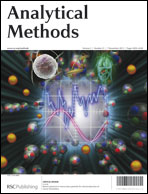Two glycosidases as label enzymes for concurrent enzyme-linked-immunosorbent-assay of two components via spectrophotometric-dual-enzyme-simultaneous-assay in one solution†
Abstract
For concomitant enzyme-linked-immunosorbent-assay (ELISA) of two analytes of interest in one well of a microplate via spectrophotometric-dual-enzyme-simultaneous-assay in one solution (SDESA), β-D-galactosidase on 4-nitro-1-naphthyl-β-D-galactopyranoside (4NNPG) and α-D-glucosidase on 4-nitrophenyl-α-D-glucopyranoside (4NPG) were tested as labels with their consistent optimum buffer (sodium phosphate buffer at pH 7.4). Hydrolysis of 4NNPG yielded 4-nitro-1-naphthol exhibiting the longest absorbance peak of 458 nm and the longest isoabsorbance wavelength of 400 nm for absorptivity equal to that of 4NNPG; hydrolysis of 4NPG produced 4-nitrophenol with the longest absorbance peak of about 405 nm. For SDESA, two enzyme reactions were initiated concurrently; absorbance of two chromogenic products was concomitantly measured in one solution via swift alternation between 450 and 405 nm with a Biotek ELX 800 microplate reader, or between 450 nm and a wavelength close to 400 nm with a spectrophotometer; the overlapped absorbance of chromogenic substances was resolved based on the linear additivity of absorbance. For separate assay, just one substrate was used to detect the corresponding label enzyme. During SDESA, initial rates of two glycosidases tolerated negligible interference from the substances involved; the use of the isoabsorbance wavelength of 400 nm to measure absorbance reduced the limit of quantification (LOQ) of α-D-glucosidase. Under the same conditions, the LOQ of either of the enzymes via SDESA was consistent with that via separate assay when activities of the other enzyme were varied over the quantifiable range. By ELISA via SDESA with penicillin G and clenbuterol in one sample as two analytes of interest, the content, the coefficient of variation, the limit of detection, LOQ and the quantification range of either of the analytes were consistent with those via separate assay when quantities of the other analyte were varied over the quantifiable range, respectively. Hence, ELISA via SDESA with those two glycosidases as labels has great promise.


 Please wait while we load your content...
Please wait while we load your content...